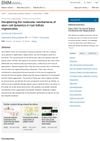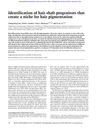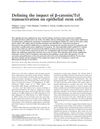TLDR Corneal cells can potentially revert to stem cells, aiding in repair and regeneration.
The review examines the dynamic relationship between limbal epithelial stem cells (LESCs) and transient-amplifying cells (TACs) in the cornea, focusing on their roles in corneal homeostasis and regeneration. It highlights the potential for TACs to dedifferentiate back into stem cells, especially after injury, suggesting a reversible transition between these cell states. This understanding could impact regenerative medicine by providing insights into tissue repair mechanisms. The review also discusses the 'XYZ hypothesis' of corneal maintenance, the influence of the limbal stem cell niche, and the identification of novel markers for LESCs and TACs. While the presence of progenitor-like cells is established in murine models, their existence in humans needs confirmation. The study suggests that corneal epithelial cells can maintain homeostasis and repair injuries without solely relying on LESCs, opening avenues for therapeutic strategies targeting the LSCN to promote corneal regeneration.

Different stem cells are key for hair growth and health, and understanding their regulation could help treat hair loss.
 145 citations
,
November 2018 in “Nature Communications”
145 citations
,
November 2018 in “Nature Communications” The Sonic hedgehog pathway is crucial for new hair growth during mouse skin healing.
 35 citations
,
July 2018 in “Cell Reports”
35 citations
,
July 2018 in “Cell Reports” The study found that a specific area of the hair follicle helps start hair growth by reducing the blocking effects on certain cells and controlling growth signals.
 44 citations
,
April 2017 in “Genes & development”
44 citations
,
April 2017 in “Genes & development” Scientists found cells in hair that are key for growth and color.
214 citations
,
April 2017 in “Cell” Different small areas within hair follicles send specific signals that control what type of cells stem cells become.
 75 citations
,
October 2016 in “Genes & Development”
75 citations
,
October 2016 in “Genes & Development” Cells in hair follicles help create fat cells in the skin by releasing a protein called Sonic Hedgehog.
20 citations
,
December 2013 in “PLoS ONE” β1 integrin is essential for the survival, growth, and movement of human epithelial progenitor cells.
53 citations
,
August 2005 in “The Journal of Cell Biology” Sgk3 is essential for normal hair follicle growth and maintenance.
 384 citations
,
June 2005 in “Genes & development”
384 citations
,
June 2005 in “Genes & development” β-catenin is essential for stem cell activation and proliferation in hair follicles.
338 citations
,
April 2001 in “Current Biology” c-Myc activation in mouse skin increases sebaceous gland growth and affects hair follicle development.





